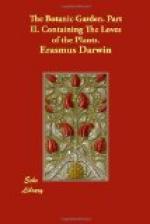But the similies of Homer have another agreeable characteristic; they do not quadrate, or go upon all fours (as it is called), like the more formal similies of some modern writers; any one resembling feature seems to be with him a sufficient excuse for the introduction of this kind of digression; he then proceeds to deliver some agreeable poetry on this new subject, and thus converts every simile into a kind of short episode.
B. Then a simile should not very accurately resemble the subject?
P. No; it would then become a philosophical analogy, it would be ratiocination instead of poetry: it need only so far resemble the subject, as poetry itself ought to resemble nature. It should have so much sublimity, beauty, or novelty, as to interest the reader; and should be expressed in picturesque language, so as to bring the scenery before his eye; and should lastly bear so much veri-similitude as not to awaken him by the violence of improbability or incongruity.
B. May not the reverie of the reader be dissipated or disturbed by disagreeable images being presented to his imagination, as well as by improbable or incongruous ones? P. Certainly; he will endeavour to rouse himself from a disagreeable reverie, as from the night-mare. And from this may be discovered the line of boundary between the Tragic and the Horrid: which line, however, will veer a little this way or that, according to the prevailing manners of the age or country, and the peculiar associations of ideas, or idiosyncracy of mind, of individuals. For instance, if an artist should represent the death of an officer in battle, by shewing a little blood on the bosom of his shirt, as if a bullet had there penetrated, the dying figure would affect the beholder with pity; and if fortitude was at the same time expressed in his countenance, admiration would be added to our pity. On the contrary, if the artist should chuse to represent his thigh as shot away by a cannon ball, and should exhibit the bleeding flesh and shattered bone of the stump, the picture would introduce into our minds ideas from a butcher’s shop, or a surgeon’s operation-room, and we should turn from it with disgust. So if characters were brought upon the stage with their limbs disjointed by torturing instruments, and the floor covered with clotted blood and scattered brains, our theatric reverie would be destroyed by disgust, and we should leave the play-house with detestation.
The Painters have been more guilty in this respect than the Poets; the cruelty of Apollo in flaying Marcias alive is a favourite subject with the antient artists: and the tortures of expiring martyrs have disgraced the modern ones. It requires little genius to exhibit the muscles in convulsive action either by the pencil or the chissel, because the interstices are deep, and the lines strongly defined: but those tender gradations of muscular action, which constitute the graceful attitudes of the body, are difficult to conceive or to execute, except by a master of nice discernment and cultivated taste. B. By what definition would you distinguish the Horrid from the Tragic?




